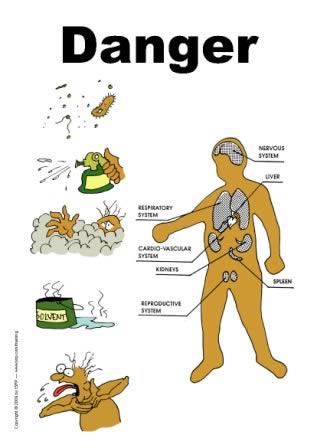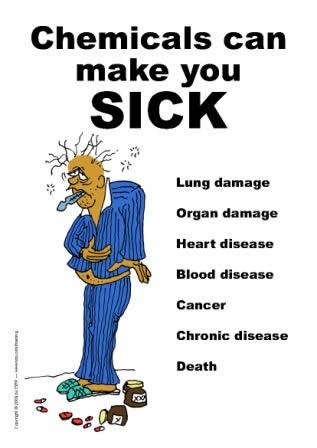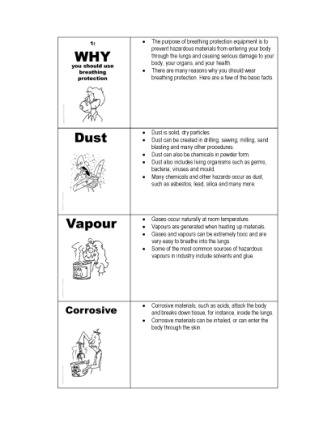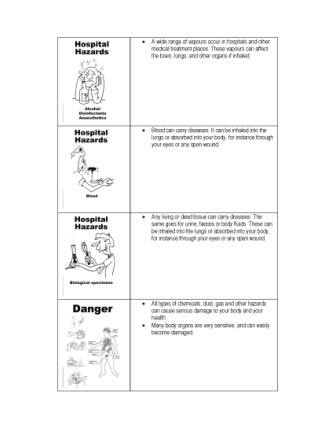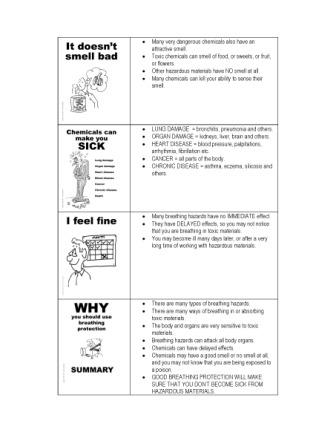ISRP Training Program for Developing Countries
The ISRP Universal Modular Train-the-Trainer Program to be used and disseminated in Developing Countries around the World
For a visual overview with sample images, click Visual Overview.
For the latest in-depth full-text description of the training program, click Complete Description.
Description
The International Society for Respiratory Protection has developed a ‘Train the Trainer’ educational program with a view to disseminate knowledge and skills in the field of occupational respiratory protection.
Train-the-Trainer approach
Makes the program long-lived in terms of effective dissemination
Use of cartoons
Makes the program suitable for use globally
High visual, low verbal content
For the sake of literacy, second-language issues and ease of translation into different languages
Many possibilities
Lets you use the material in various ways depending on local facilities and office equipment
Click tab icon to select different image to view:
The WHY and the HOW
The program is divided into two major parts: why you should use respiratory protection, and how to use it
Black & white samples
Click tab icon to select different image to view:
Colour samples
Click tab icon to select different image to view:
Trainer’s notes samples
Click tab icon to select different image to view:
Introduction
The International Society for Respiratory Protection has developed a ‘Train the Trainer’ educational program with a view to disseminate knowledge and skills in the field of occupational respiratory protection.
Background
In the past few years, it has become evident to the ISRP that there is a distinct need for awareness, acceptance and use of personal respiratory protection equipment in countless workplaces around the world, where as yet no such knowledge, equipment or occupational safety programs exist. This is particularly the case in many developing countries. The consequences are obvious:
- Inadequate or non-existent protective equipment for health-care and industrial workers
- Improper use and maintenance of protective equipment
- Lack of understanding about hazards and their effects
- Low awareness of the purpose and benefits of respiratory protective equipment
The ISRP has been approached by occupational health professionals in Africa, Asia and Europe, expressing the need for some form of training, be it in the form of self-training, class education, hands-on workshops, so-called ‘toolbox’ courses, or conventional equipment demonstrations.
Based on these requests, the ISRP has developed a training system that is now ready to be trialled and evaluated on location.
The ‘Train-the-Trainer’ principle
The ISRP is a small professional organisation with limited human resources. This is the main reason why the ‘Train the Trainer’ approach has been taken. The fundamental principle of this approach is that the ISRP can provide initial training and supply visual aids and other educational materials to health professionals and others on one single occasion and in one single location. This education and materials can then be further applied by the local trainers to a wide range of end-users of respiratory protection on a number of occasions, and in a variety of workplaces, without the need for ISRP personnel to be present.
For this purpose, the training material needs to be provided on two levels: one for the trainers, and another for the end-users.
In short, by training a small number of key personnel in a short time, these will then become trainers themselves, and can instruct a large number of people in many locations over a long period. Thus the ISRP program lives on.
Objectives
The training package is intended to give the recipients the fundamental understanding of the need for respiratory protection, the effects of various types of hazards, the basic criteria for selecting appropriate protective devices, and the necessary skills to use and maintain the equipment. The contents of the program cover the following topics:
- Recognising airborne hazards
- Understanding the reasons for and benefits of respiratory protection
- Selecting the correct type of respiratory protection
- Practising correct fitting procedures
- Verifying good fit
- Knowing when to change respiratory protective equipment
- Learning to clean, maintain and store the equipment
Training program design
The ISRP training program has been designed with developing countries in mind. This means a great variety of industries, people, locations, languages, facilities and many other factors, all presenting a number of design challenges.
Challenges
The most important design challenges are:
Wide application
The program must be suitable for many types of operations, spanning from small to large, manual to technical, service to manufacture, and so on.
Cultural issues
The program must be suitable for any audience, regardless of gender, race, social mores, religious rules, dress, and many other important factors in any society.
Language
The entire program must be easy to translate. Many workplaces employ workers of a multitude of languages; and many countries have several official languages.
Literacy
Literacy may be low in many developing countries, and the program must cater for people of limited reading skills.
Varying existing knowledge
The training should be designed in such a way that it can be used for people with no awareness of respiratory hazards or protective equipment. But it must also be possible to raise the starting point for people who do possess a measure of awareness and knowledge.
Protective equipment
The training program must be suitable for a variety of respiratory protection devices, ranging from simple disposable filtering facemasks to much more comprehensive equipment.
Training facilities
Facilities are likely to differ between countries and workplaces, and the program must be designed in such a way that it can be used in various methods of instruction for small and large groups of trainees, for example using a simple photocopied handout, or a basic overhead projector, or an animated computer presentation.
Solutions
To make the program as suitable as possible for a wide variety of industries and applications, the program has been designed as a broad, general training without any specifics. If required, this can then be adapted and added to in order to suit any particular industry. For instance, certain material already exists that addresses specific hazard issues of concern to health care workers.
The use of cartoon illustrations instead of detail drawings or photographs has a number of benefits. Cartoons can often overcome cultural barriers by being more ‘generic’ than other types of illustrations or photographs. For instance, cartoon drawings can often be more neutral when it comes to gender, facial features, clothing and so on. Furthermore, cartoon illustrations are easy to reproduce, and lend themselves to copying and distribution on simple office equipment. They have also been shown to gain a great deal of acceptance among the workforce.
The language question is usually addressed by using as few words as possible in the educational material, and to make the program highly visual. In other words, to ‘let the pictures speak’. Short captions are also easy, quick and inexpensive to translate, and the program can be converted to another language with a minimum of effort and required skills.
In order to be used in a variety of settings, the program has been designed for reproduction and display on many types of equipment. For example, the training material is supplied in both colour and black & white, so that it can be used to make overhead transparencies, photocopies, slides, or shown on a computer screen. It lends itself to be enlarged as mini-posters or as small memory-cards. The trainer has free hands to produce effective training material even with the most rudimentary office equipment.
Components
There are two main program topics: WHY use respiratory protection, and HOW to use respiratory protection. The components for both of these comprise:
- Black & white overheads/photocopies/slides (in PDF format)
- Colour overheads/photocopies/slides (in PDF format)
- Colour PowerPoint presentation (incorporating brief trainer’s notes and handout material as part of the presentation)
- Trainer’s comprehensive notes with thumbnails of all overhead sheets (in PDF format)
Trial and evaluation
The training program has been adapted somewhat to be suitable for a pilot test among health care workers in Cambodia. The pilot program is complete, and only needs to be translated into Khmer, if required. After the trial, the program can be further refined and adjusted according to comments and impressions expressed by both trainers and recipients.

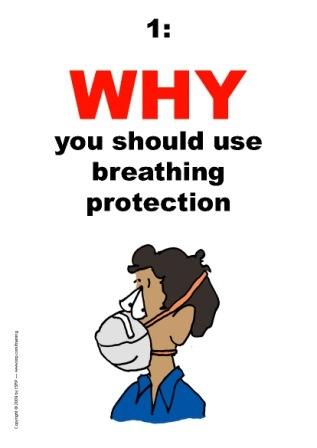
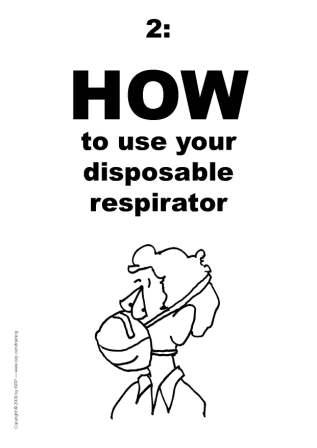
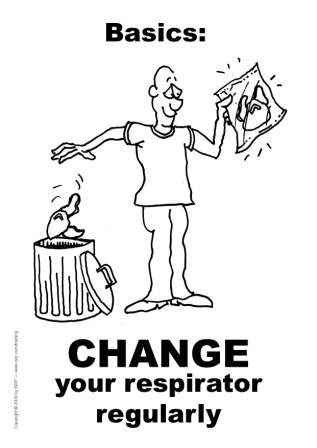
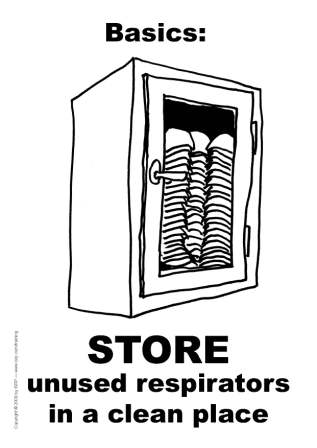
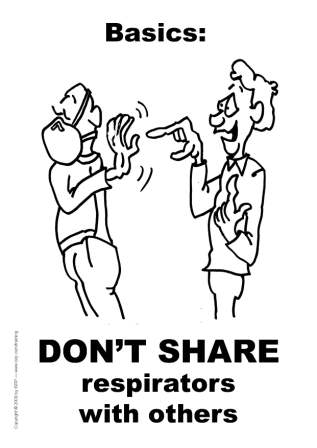
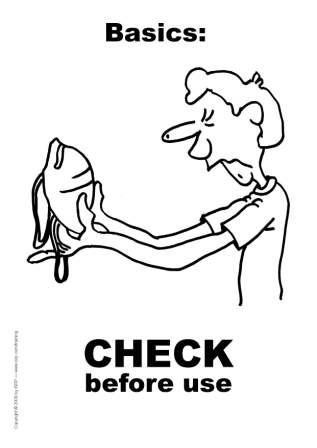
 <
< 
